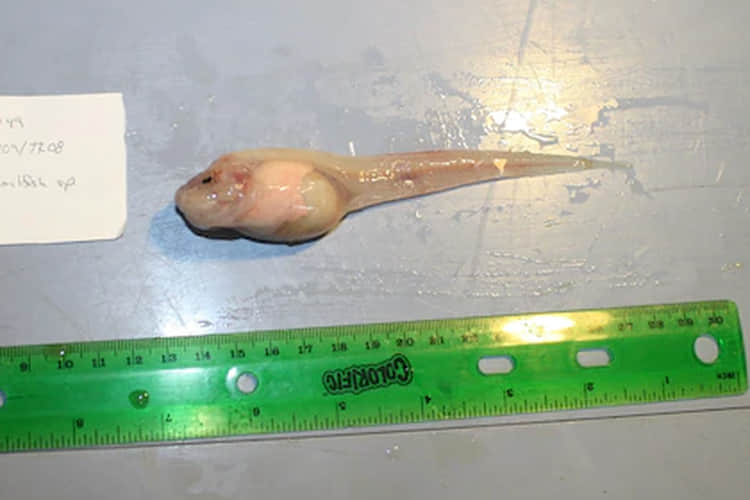
Researchers in the U.K. have found the fossilized exoskeleton of the largest arthropod to have ever lived.

These giant millipede-like creatures were the length of a car and likely roamed Earth during the Carboniferous Period, between 359 million and 299 million years ago.

The monstrous millipede ancestors, known as Arthropleura, were already known to scientists,

but the discovery of the new fossilized exoskeleton fragment confirms that these ancient invertebrates could grow to be much larger than previously expected.

Researchers discovered the new Arthropleura fossil, which is around 326 million years old, inside a fragmented block of sandstone on a beach in Northumberland in northeast England in 2018.

The exoskeleton fragment is 2.5 feet (75 centimeters) long and 1.8 feet (55 cm) wide.

This means the individual that molted it would have been around 8.5 feet (2.6 meters) long and weighed around 110 pounds (50 kilograms), according to the researchers.
“These would have been the biggest animals on land in the Carboniferous,” lead researcher Neil Davies, a geologist at the Department of Earth Sciences at the University of Cambridge in England, told Live Science.

Researchers had suspected that Arthropleura could potentially grow to these extreme sizes but were still very surprised to find any direct evidence of this, he added.

– A fortunate find –
The fossil discovery was “very lucky”
because the area where the exoskeleton was found “is not a place known for fossils,” Davies said. It was also very fortunate that the fossil was visible, he added.

“The block containing the fossil had recently fallen from the cliff and cracked in just the right place,” Davies said. The exposed fossil was then found by a former doctoral student who happened to be walking past.

Molted exoskeletons do not normally fossilize well because they quickly break down. But this one was exceptionally well preserved.

“It seems to have filled with sand soon after it was molted,” Davies said. “It is in a fossilized river channel, so it likely fell into a small river and got entombed in other sediment very quickly.”

Only two other Arthropleura fossils have ever been discovered, both in Germany, Davies said. The new fossil is the oldest and largest discovered yet.

Everything else that researchers know about the giant invertebrates has come from fossilized footprints, or trackways, they left behind, which have been discovered in Europe and North America.

– Monster millipedes –
The researchers were able to estimate the size of this new individual based on previous findings of fossils and trackways.

“Smaller Arthopleura examples have a common width:length ratio of 4.78,” Davies said. “So, as our animal was definitely 55 cm wide, that makes it 2.63 m long.”

Researchers are not exactly sure what Arthropleura ate because no head has ever been found.

But they suspect that these beasties were most likely vegetarians and would have likely feasted on trees, plants and nuts. However, they may have also eaten other small invertebrates too.

It is also unclear how many legs Arthropleura might have had. “The more complete ones fossils are thought to have 32 segments, but it is unclear if they had two legs per segment 64 legs or every two segments 32 legs,” Davies said.

Trackways left by this individual suggest that it had at least 20 legs, he added.

Recently, a new species of living millipede was found to have 1,300 legs, Live Science previously reported, but most living species have fewer than 100 legs.

– Changing climate –
Arthropleura would have been “very common around the equator,” which at the time would have likely been much closer to what is now the U.K., Davies said.

Earth’s equator can move around due to a phenomenon known as true polar wander, which occurs when the outer layer of a planet or moon moves around its core, tilting the crust relative to the object’s axis.

This “cosmic yo-yo”
last occurred around 84 million years ago, Live Science previously reported.

The tropical climate in what is now the U.K. during the Carboniferous period, as well as a lack of predators and other large animals, are likely what allowed these invertebrates to grow to such extraordinary sizes.

“It was probably just an environment that suited them being huge,” Davies said. They would have had “a large supply of food from trees and plants, and not much competition from other animals.”

However, conditions didn’t remain perfect for Arthropleura, and they eventually went extinct around 45 million years after they first appeared.

A shift in the equator towards its current location during the early Permian Period, 299 million to 252 million years ago, likely changed the climate and enabled the first reptiles to thrive on land, Davies said.
“Effectively they Arthropleura would have faced more competition for fewer resources, and eventually lost out to more efficient animals,” he added.
.


Ref: wikipedia, geologyin, livescience, allthatsinteresting, newscientist, npr
Pic: sci-news, wikipedia, geologyin, esconi, pinterest, giantmillipedes, ukfossils, cmnh.org, komu, discoveringfossils, shaletrail, 9gag, dailynationtoday, livescience





